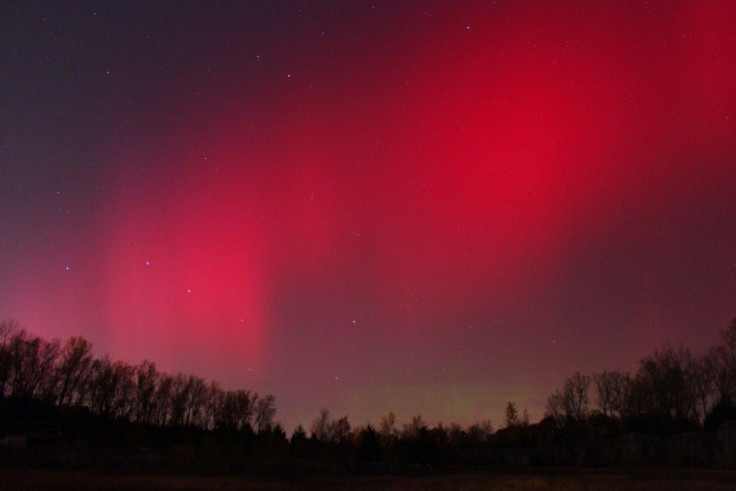Northern Lights Take A Trip South

Millions across the U.S. were treated to a spectacular display Monday as the Aurora Borealis dipped south to the delight of spectators across 30 states. Stargazers as far south as Arizona, New Mexico, and Alabama caught the vivid red patterns of the northern lights, which arrived in our atmosphere approximately 41 hours after an eruption on the surface of the sun.
Aurora Borealis displays occur when solar flares - also called CMEs, or coronal mass ejections - erupt from the sun's surface in a high-intensity burst of radiation. These gusts of solar wind, containing charged electrons and protons, are often propelled with enough force to hurtle headlong into Earth's magnetic field, compressing it and exciting the electrons of the oxygen and nitrogen within it. As the energy is dispersed along the field, much of it is released in the form of the photons or when charged particles collide. Collisions with oxygen particles tend to result in green emissions, while collisions with nitrogen result in blue or red. If the resulting displays take place in the northern hemisphere, they are called Aurora Borealis, while events in the southern hemisphere are Aurora Australis.
As solar storms go, the one that triggered the Aurora Borealis on Monday was not particularly strong, registering as a 7 out of 9 on the scale used to measure such magnetospheric disturbances. It erupted on the Sun's surface around 0100 Universal Time on October 22, traversing the distance between sun and Earth in approximately 41 hours. Speaking to the AP, forecast chief at the Space Weather Prediction Center Bob Rutledge said that given the storm's moderate size, it was surprising that the lights were visible south of Iowa. Additionally, the predominantly red hue of Monday's display is fairly rare, making the event a
The Aurora Borealis were also seen in Wisconsin, Tennessee, Missouri, Illinois, Nebraska, Kentucky, North Carolina, Indiana, Oklahoma, Kansas, Iowa, Maryland, New York, Montana, Ohio, Colorado, Pennsylvania, Washington, Virginia, Texas, Minnesota, Maine, Michigan, Montana, Oregon, Arkansas and California.
If you missed the northern lights on Monday night, good news: the current solar cycle is expected to hit its peak in 2012 to 2013, so we can expect a great many more chances to see aurora over the next two years. For those who want to be alerted to the next event, monthly subscriptions starting at $4.95 per month to Spacweathertext.com will buy you alerts via text of solar flares, geomagnetic storms, coronal mass ejections, big sunspots, and Northern Lights.
© Copyright IBTimes 2024. All rights reserved.




















